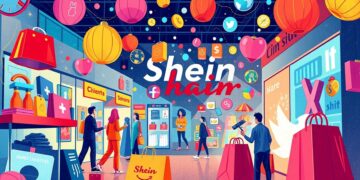The Role of Influencer Marketing in Shein’s Sales

Influencer Marketing and Shein: A Dynamic Duo
In today’s fast-paced retail landscape, influencer marketing has emerged as a crucial strategy for brands seeking to connect with a younger audience. Shein, the online fashion retailer renowned for its trendy apparel at affordable prices, has embraced this trend, leveraging various social media platforms to boost its sales and visibility. The company’s approach demonstrates the power of social media in shaping consumer buying behavior, particularly among Generation Z and millennials.
Enhancing Brand Reach through Influencer Partnerships
One of the primary benefits of influencer marketing for Shein is the enhanced brand reach it promises. By partnering with social media influencers, Shein can tap into their vast follower networks, which often include millions of engaged users. For instance, influential fashion bloggers and lifestyle vloggers showcase Shein’s products in relatable contexts, making the brand more visible and appealing. This kind of exposure not only increases brand awareness but also creates consumer curiosity that drives traffic to Shein’s website.
Targeted Promotions and Consumer Engagement
Beyond mere visibility, targeted promotions have proven effective in engaging followers. Influencers often employ unique discount codes specifically for their audience, encouraging immediate purchases. For example, when an influencer drops a YouTube video featuring a “Shein Haul,” they might offer a code that provides their viewers with a discount on their next order. This direct and personal call-to-action motivates followers to act swiftly, thereby improving conversion rates for Shein.
The Power of Micro-Influencers
Collaboration with micro-influencers is another key strategy for Shein, and it greatly contributes to building brand authenticity. Micro-influencers typically have smaller, yet highly engaged audiences. By partnering with these less mainstream influencers, Shein creates a more authentic connection with potential buyers. For example, a micro-influencer with 50,000 dedicated followers may have a 20% engagement rate compared to a macro-influencer with 1 million followers and only a 5% engagement rate. This loyalty often translates into a more trusting relationship, fostering increased sales.
Interactive Shopping Experiences
Platforms like Instagram and TikTok have transformed the shopping experience into something interactive and engaging. Shein capitalizes on this by creating visually appealing content, showcasing stylish outfits on popular influencer accounts, and even incorporating fun and engaging formats like live shopping events. These interactive experiences not only capture users’ attention but also provide them with an effortless shopping journey, leading to impulse purchases.
Conclusion: The Future of Retail
As we explore the intricate relationship between influencer marketing and Shein’s sales growth, it becomes evident that this strategy is set to play a pivotal role in the future of retail. The combination of influencer partnerships, targeted promotions, and the use of social media as a shopping platform creates a dynamic atmosphere that is hard to replicate. The continued evolution of influencer marketing promises to keep brands like Shein at the forefront of the retail landscape, shaping how consumers interact with fashion in a digital-first world.
DISCOVER MORE: Click here for insights on social media influencers
Unpacking Shein’s Influencer Strategy
In a digital age where social media dominates daily interactions, Shein’s marketing strategy amplifies the essence of influencer collaborations. By leveraging these partnerships, Shein is not only boosting its visibility but also altering the traditional avenues of shopping. This innovative approach is particularly effective in enticing a young consumer base, who are increasingly turning to digital platforms for their shopping needs. To understand the depth of this strategy, it’s essential to examine how Shein integrates influencers into their marketing mix.
The Rise of Social Commerce
As consumers become more accustomed to shopping online, the phenomenon known as social commerce has taken center stage. Brands like Shein are capitalizing on this by creating seamless shopping experiences directly within social media apps. Notably, platforms such as Instagram and TikTok are equipped to facilitate purchases, allowing users to buy items featured in influencer posts instantly. This convenience resonates well with young shoppers, who often favor quick and easy purchasing options.
Creating Authentic Storytelling
Influencers serve as more than just promotional tools; they are storytellers who can communicate the essence of a brand like Shein. Through personal anecdotes, styling tips, and real-life try-ons, influencers make products relatable and accessible. This authentic storytelling fosters emotional connections with potential customers. Here are a few structural elements that enhance this strategy:
- Visual Appeal: High-quality visuals and engaging content draw attention and create a desire for Shein’s offerings.
- Relatable Context: Influencers showcase outfits in real-life scenarios, allowing followers to envision how the pieces fit into their own lives.
- Peer Recommendations: Recommendations from individuals whom consumers trust often hold more weight than traditional advertising.
Building Community and Fostering Loyalty
Moreover, Shein nurtures a sense of community through its influencer partnerships. By supporting influencers who align with their brand values, Shein cultivates a loyal consumer base. Engagement extends beyond mere product promotions; followers are encouraged to share their own Shein looks on social media, further creating a vibrant online community. This strategy not only enhances brand loyalty but also turns customers into brand advocates, driving organic conversion with minimal additional investment.
Data-Driven Insights
Shein’s formidable approach to influencer marketing is backed by data and analytics that track engagement and sales metrics. By closely monitoring which posts generate the most interaction or lead to significant sales spikes, Shein fine-tunes its influencer collaborations for optimal results. This data-driven methodology ensures that marketing spend is directed toward the most effective campaigns, reinforcing the symbiotic relationship between Shein and its influencers. It highlights the potency of analytics in modern marketing contexts, establishing a strong foundation for future strategies.
In conclusion, Shein’s utilization of influencer marketing isn’t a mere trend; it’s a formidable strategy dedicated to navigating the complexities of the digital marketplace. From engaging communities to personal storytelling, the role of influencers is undeniably vital in Shein’s sales growth and overall brand presence.
In recent years, Shein has emerged as a powerhouse in the fast-fashion industry, and a significant part of its success can be attributed to its innovative use of influencer marketing. This strategy not only boosts brand awareness but also drives substantial sales growth, tapping into the vast potential of social media platforms.One of the key aspects of Shein’s influencer marketing strategy is its collaborations with a diverse range of social media influencers, from micro-influencers to larger celebrities. This allows Shein to target various demographics effectively. By leveraging the authenticity and relatability of influencers, Shein is able to present its products in a way that feels more personal to potential customers, thereby increasing the likelihood of conversions. Influencers bring their unique styles and personalities to Shein’s products, showcasing outfits in real-life scenarios that resonate with their followers.Moreover, influencer marketing enhances Shein’s online presence and visibility. With the powerhouse of platforms like Instagram, TikTok, and YouTube, influencers create engaging content that showcases Shein’s latest collections, often sparking viral trends. For instance, the #SheinHaul challenge has gained traction, where influencers share haul videos, captivating audiences and showcasing a plethora of Shein’s offerings. This user-generated content serves as both a promotional tool and a form of social proof, making potential customers more inclined to splurge on their next wardrobe addition.In addition to reaching new audiences, influencer collaborations also foster a sense of community among Shein’s consumers. Influencers often encourage discussions around fashion trends, sustainability, and body positivity, aspects that resonate deeply with Shein’s target market. This engagement fosters brand loyalty, as consumers feel a connection not just to the products, but to the brand’s overarching message.Ultimately, influencer marketing has transformed how Shein approaches its sales strategy, driving both immediate purchases and long-term brand loyalty. The effectiveness of this marketing approach is evidenced by Shein’s soaring popularity and sales figures, reflecting how aligning with influencers can yield monumental success within the highly competitive fast-fashion industry. This evolving landscape invites further exploration into the broader implications of influencer partnerships, not just for Shein but for the retail industry as a whole.
DIVE DEEPER: Click here to learn about Shein’s innovative strategies</
Influencers: The New Age Brand Ambassadors
As the digital landscape evolves, so too does the role of influencers in shaping consumer behavior. No longer just celebrities or recognized figures, today’s influencers range from micro and nano influencers to niche content creators who resonate deeply with their audiences. Shein’s marketing approach leverages this diversity, recognizing that even influencers with smaller followings can wield significant purchasing power. By engaging a variety of influencers, Shein successfully targets demographic segments that might otherwise be overlooked.
The Power of Authenticity
In an era where consumers are increasingly skeptical of traditional advertising, authenticity has become paramount. Influencers who authentically incorporate Shein products into their lifestyle captivate their followers’ attention. The ability of influencers to curate a personal and genuine narrative allows consumers to feel more connected to the brand. Data from recent studies indicates that approximately 70% of millennials trust brand recommendations from influencers they follow. This metric elucidates how Shein’s strategy isn’t just about promotional content, but about building trust and credibility through relatable narratives.
Leveraging Trends and Content Virality
Moreover, the fast-paced nature of social media trends plays into Shein’s hands. The brand quickly aligns its influencer campaigns with the latest trends, whether it’s seasonal fashion, challenges, or viral hashtags. For instance, during peak seasons like spring break and back-to-school, Shein capitalizes on influencers creating content around relevant themes, thereby driving traffic and conversions simultaneously. As a result, campaigns not only enhance product visibility but also create a sense of urgency among potential buyers, prompting immediate purchasing decisions.
Maximizing Engagement through Interactive Content
Shein encourages its influencers to create interactive content, such as polls, quizzes, and “get ready with me” videos, which stimulate engagement. Interactive content has been shown to increase consumer retention significantly—by as much as 80%. This suggests that the more engaged a potential customer feels, the higher the likelihood of conversion. By incorporating fun and engaging formats, Shein taps into its audience’s preferences, driving both engagement and sales.
Strategic Brand Partnerships
In addition to individual influencers, Shein has also fostered collaborative partnerships with larger influencers and fashion icons, further solidifying its standing in the industry. These collaborations often result in exclusive product lines or collections, elevating the overall brand appeal while creating a buzz among fans. For example, when partnering with high-profile influencers for limited-edition collections, Shein has seen a significant increase in sales volume, demonstrating the effectiveness of strategic alignment with well-established figures in the fashion world.
Tapping into User-Generated Content
Shein not only utilizes influencers but also encourages user-generated content (UGC) among its customer base. By creating campaigns that invite customers to share photos wearing Shein products, the brand capitalizes on organic promotion. This strategy not only offers social proof but also builds a sense of community. Platforms like Instagram and TikTok flourish on visual content, and Shein has harnessed the power of its own customers to amplify organic reach, resulting in enhanced visibility and increased sales.
Through these layered strategies, Shein effectively utilizes influencer marketing to maintain its competitive edge in the online retail space. By fostering a deep alliance with influencers, Shein enhances its brand reputation and continues to grow its market share in the fast-fashion industry.
DISCOVER MORE: Click here for essential tips
Conclusion: The Future of Shein’s Success Through Influencer Marketing
In conclusion, the role of influencer marketing in Shein’s sales is not just a passing trend; it represents a fundamental shift in how brands connect with consumers in the digital age. By harnessing a diverse array of influencers, from micro-creators to fashion icons, Shein has strategically positioned itself to engage a broad audience and cultivate authentic relationships with potential buyers. The power of authenticity, coupled with the agility to leverage trends and foster interaction, underlines Shein’s innovative approach to marketing.
Moreover, the emphasis on user-generated content and strategic partnerships demonstrates Shein’s understanding of modern shopping behaviors and preferences. The brand’s ability to blend promotional strategies with community engagement not only enhances visibility but also drives conversion rates significantly. As data suggests, engaging content fosters lasting loyalty—a vital component in the competitive landscape of fast fashion.
Looking ahead, the implications of Shein’s influencer marketing strategy extend beyond mere sales figures. As e-commerce continues to evolve, brands may find themselves following Shein’s lead in adopting similar practices. By prioritizing genuine connections, quick adaptation to cultural shifts, and the seamless integration of influencers into their brand narratives, Shein not only redefines consumer experiences but also sets a new standard for success in the fashion retail sector. For marketers and brands alike, examining Shein’s innovative tactics offers invaluable insights into the future trends that will shape the industry.

Linda Carter is a digital business trends writer and strategist specializing in emerging technologies and online revenue models. With extensive experience helping entrepreneurs and professionals adapt to the digital economy, she shares actionable insights on our platform about monetization strategies, consumer behavior shifts, and next-wave innovations. Her goal is to empower readers with practical frameworks to future-proof their businesses and capitalize on digital opportunities.





